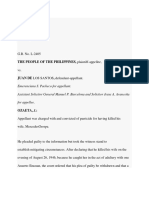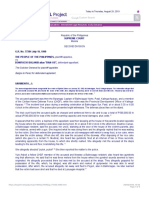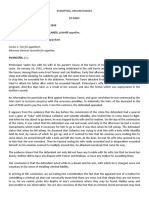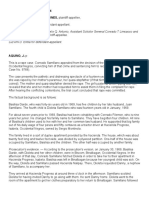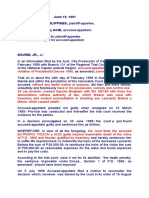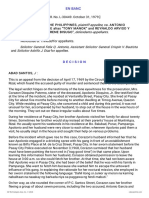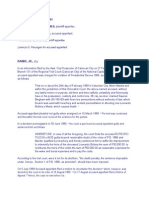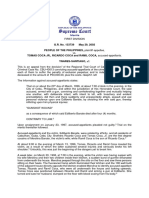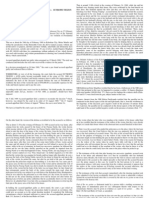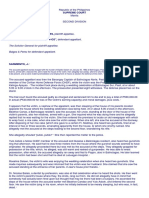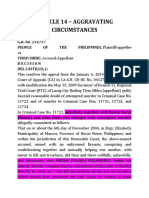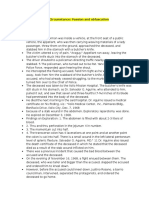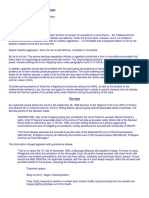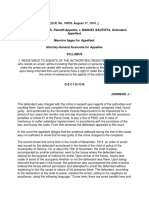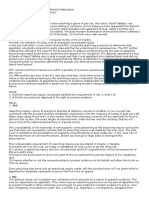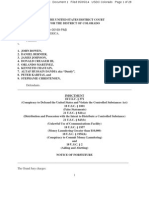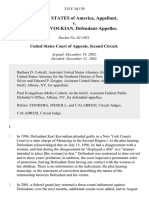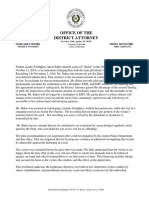Supreme Court: Yolanda G. Villaruz For Appellant. Office of The Solicitor General For Appellee
Supreme Court: Yolanda G. Villaruz For Appellant. Office of The Solicitor General For Appellee
Uploaded by
Rigel VillanuevaCopyright:
Available Formats
Supreme Court: Yolanda G. Villaruz For Appellant. Office of The Solicitor General For Appellee
Supreme Court: Yolanda G. Villaruz For Appellant. Office of The Solicitor General For Appellee
Uploaded by
Rigel VillanuevaOriginal Description:
Original Title
Copyright
Available Formats
Share this document
Did you find this document useful?
Is this content inappropriate?
Copyright:
Available Formats
Supreme Court: Yolanda G. Villaruz For Appellant. Office of The Solicitor General For Appellee
Supreme Court: Yolanda G. Villaruz For Appellant. Office of The Solicitor General For Appellee
Uploaded by
Rigel VillanuevaCopyright:
Available Formats
Republic of the Philippines SUPREME COURT Manila SECOND DIVISION G.R. No.
L-32792 February 2, 1979 PEOPLE OF THE PHILIPPINES, plaintiff-appellee, vs. DIONISIO BASTASA @ DIONY and VIRGINIA DUGENIA BASTASA @ VIRGIE, defendants. DIONISIO BASTASA alias "DIONY"; defendant-appellant. Yolanda G. Villaruz for appellant. Office of the Solicitor General for appellee.
CONCEPCION JR ., J.: In Criminal Case No. 4609 of the Court of First Instance of Zamboanga del Norte, the spouses Dionisio Bastasa and Virginia Bastasa were charged with the crime of murder, allegedly committed as follows:
That in the evening on or about the 2nd day of December, 1966, in the municipality of Dipolog, Zamboanga del Norte, within the jurisdiction of this Honorable Court, the abovenamed accused conspiring confederating and working together, armed with firearm and with intent to kill by means of treachery and evident premeditation did, then and there way, unlawfully and feloniously shoot Atty. SOLOMON SUDIACAL thereby inflicting upon him multiple gunshot wounds on various parts of his body at least one of which caused his death on the spot. 1
xxx xxx xxx When arraigned on February 17, 1967, both accused entered a plea of not guilty; 2 thereafter, trial proceeded and the prosecution as well as the defense adduced their respective evidence. After the trial on July 16, 1970, the trial court rendered a decision, 3 the pertinent part of the dispositive portion of which reads as follows:
IN VIEW OF ALL THE FOREGOING CONSIDERATIONS, the Court, declaring that the prosecution has proved beyond reasonable doubt the guilt of accused Dionisio Bastasa a Diony of the crime of murder in the character of principal with the concurrence of the aggravating circumstance of evident premeditation, which, however, is offset by the mitigating circumstance of his voluntary wander to the PC authorities in Sicayab, Dipolog, Zamboanga del Norte soon after he committed said crane, and that accused Virginia Dugenia Bastasa @ Virgie, was only accessory after the fact in the crane under paragraph 3 of Article 19 of the Revised Penal Code, for which reason, as spouse of said accused Dionisio Bastasa @ Diony, she is exempt from any criminal liability, hereby sentences accused Dionisio Bastasa @ Diony to the penalty of reclusion perpetua, with the accessories of the law, to indemnify the heirs of the deceased victim Atty. Solomon Sudiacal in the sum of Twelve Thousand Pesos (P12,000.00), without subsidiary
imprisonment in case of insolvency, to pay them Ten Thousand Pesos (P10,000.00) as moral damages and Five Thousand Pesos (P5,000.00) as exemplary damages, and to pay one-half (1/2) of the costs, and declares accused Virginia Dugenia Bastasa alias Virgie acquitted from the charge in the information, with one-half (1/2) costs de oficio and cancellation of her bond for her provisional liberty. Accused Dionisio Bastasa @ Diony will be credited with the full period of his preventive imprisonment if he agrees in writing to abide by the laws and disciplinary rules imposed upon convicted persons, and with only 4/5 thereof if he does not so agree. 4
xxx xxx xxx Dissatisfied with the above judgment, the accused Dionisio Bastasa interposed the present appeal pleading among others, that the trial court erred in not applying the provisions of Article 247 of the Revised Penal Code in the imposition of the penalty. The evidence for the prosecution shows that from 6:30 to 7:00 o'clock in the evening of December 2, 1966, the deceased Atty. Solomon Sudiacal was with his wife Leonora Lacaya Sudiacal a pharmacist in their drug store at Dipolog, Zamboanga del Norte. After 7:00 o'clock that evening, the deceased left their drug store. His wife did not know where he was going; however, she was then expecting that he (the deceased) would go to Katipunan, 5Zamboanga del Norte. Instead of going to Katipunan, the deceased went to the house of the spouses Dionisio Bastasa and Virginia Bastasa at Jones Street, Dipolog, Zamboanga del Norte, to find out if the appellant Dionisio Bastasa with whom he had placed an order for cigarettes had already arrived from Zamboanga City. Having been informed by Virginia Bastasa that the appellant had not yet arrived, the deceased decided to wait for him. He then sat on a chair in the sala, while Virginia Bastasa, who had her back to him, sewed on a sewing machine. Thereafter, while the deceased was in the sala sitting and scanning a fashion magazine, the appellant fired shots at him. 6 Meanwhile, at about 8:30 in the evening of that day, Francisco Balboza, Jr. together with Blanco Carreon and other students were playing cards at the second floor of the house rented by Leoncio Corpuz. After playing cards at around 9:30 in the evening, the two decided to go home. While they were downstairs, they heard shots coming from the house of the Bastasa spouses. When they looked at the appellant's house they saw a man who turned out to be the deceased Atty. Solomon Sudiacal fully clothed, his face soaked in blood, slowly walking towards the kitchen while the appellant was behind him aiming a gun at him. Appellant then fired at the deceased who thereafter fell on the floor of the kitchen. 7 Francisco Balboza, Jr. and his companion went nearer to the house of appellant, and standing on a coconut stamp, they saw appellant's wife Virginia Bastasa come out from their room. Thereupon, the spouses undressed the deceased and brought his naked body to the sala and then to the balcony. Not long afterwards, they heard four or five successive shots, and thereafter, the appellant and his wife left their house. 8 On the other hand, the appellant Dionisio Bastasa admitted that he shot the deceased in his house in the evening of December 2, 1966. His version of the incident is as follows: On November 30, 1968, he went to Zamboanga City without informing his wife when he would return to find out from the Bureau of Customs what foreign boat would dock at Pulawan and to pay for the boarding permit. 9 On December 2, 1966, he went home, arriving at Dipolog City at about 9:00 o'clock in the evening of that day. On his way home, he was surprised to see the jeep of the deceased Atty. Solomon Sudiacal parked along General Luna Street near the establishment Or store of one Omamalin about 70 meters away from his house. 10 Arriving home, he passed through the secret passage leading to
the old balcony of his house, which he used to pass especially when going home at night in order not to disturb his wife and children who were already asleep. 11 Upon reaching the balcony, he saw a jacket on top of the center table in the sala. He went inside to find out who owned the jacket, and as he approached the center table, he also found thereon a 45 caliber pistol. 12 Believing that somebody was inside their bedroom, he took the pistol and went downstairs passing through the same old balcony. 13 After finding that the pistol was loaded, he climbed the ladder on the northern side of the house where he could see who was inside without being noticed. 14 When he reached the top of the ladder, he saw the deceased, naked from the waist, lying down with his wife and having sexual intercourse with her. Somehow his feet slipped from the ladder and he took hold of a board which created some noise. Immediately thereafter, the deceased stood up. At that moment, he shot the deceased four times, and the latter ran out of the bedroom to the sala and picked up his jacket. Again, he fired three more shots at the deceased, who ran to the kitchen with the jacket on his breast. Then he climbed down the ladder to pursue the deceased upstairs. 15 While the appellant was about to go up the house, he heard a sound as if a body crashed against the plywood board, which served as a provisional shutter of the door of the new balcony, he saw the plywood board fall down with the deceased. Thereafter, he went up the house, and again, he shot the deceased two more times. Thereupon, he turned over the body of the deceased which was then lying face downward and thereafter removed his trousers with the intention of cutting his penis but desisted when he heard the sound of an approaching jeep. Immediately, he left the house and placed the pistol on the stomach of the deceased. Failing to get a motorcab, he went to the house of his uncle, Dr. Destura, where he took the latters car and proceeded to the house of his cousin Gregorio Bastasa, whom he requested to get in touch with his (Bastasa's) parents to secure a bond for him. From there, he went to the PC Headquarters at Sicayab, Dipolog, Zamboanga del Norte, and surrendered, informing them that he killed a man inside his own house. 16 The Solicitor General is inclined to believe the version of the appellant. It is his observation that appellant's version is more credible than that of the prosecution because it is consistent with the physical facts of the case, namely: (a) the presence of four empty bullet shells on the floor of the bedroom supports appellant's statement that he aimed and fired four shots at the deceased while the latter was inside the bedroom; 17 (b) the absence of bullet holes on the T-shirt of the deceased although he sustained several wounds on the breast affirms appellant's statement that the deceased had only his pants on when he shot him; 18 (c) the fact that the bullet holes on the jacket of the deceased do not tally with the bullet wounds found on the upper portion of the deceased's body substantiates appellant's statement that the jacket was held by the deceased as shield for his breast when fired at in the sala the multiplicity of the holes thereon apparently were occasioned by the fact that the deceased held the jacket in a crumpled manner towards his breast; 19 (d) the fact that the fashion magazines, found by the police authorities lying under a small table in the sala, have bullet holes on them, one from cover to cover and the other up to page 31 thereof where the slug was found embedded, proves that the deceased could not have been sitting on a chair in the sala scanning a fashion magazine (the one with bullet holes from cover to cover) when the first shots were fired at him; the probability being that a bullet fired at the deceased while he was already in the sala from the bedroom found its mark on the fashion magazines as they lay under a small table one on top of the other;20 and (e) the fact that the dead body of the deceased was found completely naked in the living room on top of a piece of plywood with the jacket under his right arm and his pants below his feet verifies the truth of appellant's declaration that while he was climbing down the ladder he heard a banging of the plywood board which served as temporary door shutter of the new balcony of the house and that he saw the deceased fall down with the board. 21 The Solicitor General has also observed that the antecedent facts of the casa particularly the ongoing illicit relations between the deceased and the appellant's wife, are duly established by the evidence and provide ample basis for the conclusion that the deceased's real purpose in going to
appellant's house on that fateful evening of December 2, 1966 was to indulge in the sexual act with appellant's wife. 22 This conclusion is bolstered by the disclosure of the records that on November 30, 1966 appellant lift his residence in Dipolog City for Zamboanga City without informing his wife when he would be returning home. 23 Indeed, according to the Solicitor General, it was a perfect opportunity for the deceased to indulge in sexual act with Mrs. Bastasa, what with her husband away from home. 24 Thus, the Solicitor General concludes that the appellant killed the deceased under the conditions stated in Article 247 of the Revised Penal Code, and, consequently, recommends that the appellant be sentenced to suffer the penalty of destierro, in accordance with said article. 25 We have carefully examined the records of this case and We agree with the observations of the Solicitor General as well as his conclusion that the appellant killed the deceased while in the act of committing sexual intercourse with the appellant's wife, Virginia Bastasa. Accordingly, the appealed decision must be modified and the appellant sentenced to suffer the penalty of destierro as provided for by the first paragraph of Article 247 of the Revised Penal Code, to wit: .ART. 247. Death or physical injuries inflicted under exceptional circumstances. Any legally married person who having surprised his spouse in the act of committing sexual intercourse with another person, shall kill any of them or both of them in the act or immediately thereafter, or shall inflict upon them any serious physical injury, shag suffer the penalty of destierro. We have noted, however, that the appellant has been under preventive imprisonment since December 2, 1966; or a period of almost twelve (12) years to date. Considering that the penalty of destierro has a duration of from six months and one day to six years, it appears that appellant has more than served the full duration of the penalty imposable on him, even if lie be credited with only four- fifths of his preventive imprisonment a period of nine years and six months-pursuant to Article 29 of the Revised Penal Code, as amended, which reads: ART. 29. Period of preventive imprisonment deducted from term of imprisonment. Offenders who have undergone preventive imprisonment shall be credited in the service of their sentence consisting of deprivation of liberty, with the full time during which they have undergone preventive imprisonment, if the detention prisoner agrees voluntarily in writing to abide by the same disciplinary rules imposed upon convicted prisoners, except in the following cases: 1. When they are recidivists, or have been convicted previously twice or more times of any crime; and 2. When upon being summoned for the execution of their sentence they have failed to surrender voluntarily. If the detention prisoner does not agree to abide by the same disciplinary rules imposed upon convicted prisoners, he shall be credited in the service of his sentence with four-fifths of the time during which he has undergone preventive imprisonment. (As amended by Republic Act No. 6127, June 12, 1970). This brings Us to the question of whether or not the benefits of Article 29 aforequoted can be extended to the appellant, considering that the penalty imposable on him is destierro. We hold the affirmative view. Article 29 of the Revised Penal Code applies when the penalty to which the accused has been sentenced consists of deprivation of liberty. 26 The penalty of destierro, according
to this Court in Uy Chin Hua v. Dinglasar; 27 means banishment or only a prohibition from residing within the radius of 25 kilometers from the actual residence of the accused for a specified length of time. Although destierro does not constitute imprisonment (which is a typical example of deprivation of liberty), it is nonetheless a deprivation of liberty. 28 It follows that Article 29 is applicable when the penalty imposed is destierro. Therefore, in the instant case where the penalty of destierro is to be imposed on the appellant, the benefits of Article 29 should be extended to him, that is, he should be credited with the time during which he has undergone preventive imprisonment. ACCORDINGLY, the judgment of the trial court is modified holding the appellant Dionisio Bastasa alias "Diony" guilty of the crime of killing the victim, Solomon Sudiacal, under exceptional circumstances as defined and under Article 247 of the Revised Penal Code, as amended, and is hereby sentence to suffer the penalty of destierro. Considering the preventive imprisonment that he has undergone, he is hereby ordered released immediately from custody. No pronouncement as to costs. SO ORDERED. Fernando, (Chairman), Barredo, Antonio, Aquino and Santos, JJ., concur. Abad Santos, J., took no part.
You might also like
- G.R. No. L-31375Document6 pagesG.R. No. L-31375Gideon SosaNo ratings yet
- Varkey JosephDocument3 pagesVarkey JosephVaishnaviSankarNo ratings yet
- People V VerzolaDocument12 pagesPeople V VerzolaArJanNo ratings yet
- Case DigestDocument18 pagesCase Digestalminiana.218.00358m.bscrimNo ratings yet
- THE PEOPLE OF THE PHILIPPINES, Plaintiff-AppelleeDocument23 pagesTHE PEOPLE OF THE PHILIPPINES, Plaintiff-AppelleeprocopyoNo ratings yet
- People Vs Binondo GR97227 Oct 20 1992Document5 pagesPeople Vs Binondo GR97227 Oct 20 1992Jessie AncogNo ratings yet
- Criminal Case Digest: People of The Philippines vs. Francisco Dacillo and Joselito Pacot Y IbarraDocument7 pagesCriminal Case Digest: People of The Philippines vs. Francisco Dacillo and Joselito Pacot Y IbarraAAMCNo ratings yet
- People Vs Tiozon-People Vs AgustinDocument8 pagesPeople Vs Tiozon-People Vs AgustinDan LocsinNo ratings yet
- Legal Med - Murder CaseDocument24 pagesLegal Med - Murder Caselou annNo ratings yet
- Perpetua and Order Him To Indemnify Margarita Paleng by Way of Moral Damages in TheDocument9 pagesPerpetua and Order Him To Indemnify Margarita Paleng by Way of Moral Damages in TheJose Daniel VirreyNo ratings yet
- People vs. DacilloDocument7 pagesPeople vs. DacilloEmily MontallanaNo ratings yet
- People V Francisco DacilloDocument8 pagesPeople V Francisco DacilloDuffy DuffyNo ratings yet
- G.R. No. 77284Document5 pagesG.R. No. 77284Dianne MiralNo ratings yet
- Exempting CircumstancesDocument184 pagesExempting Circumstancesroh peeNo ratings yet
- People of The PH v. AmillanoDocument5 pagesPeople of The PH v. AmillanoMary Jane CayloNo ratings yet
- Crim Pro CasesDocument15 pagesCrim Pro CasesFatima Fayea MejoradaNo ratings yet
- The Solicitor General For Plaintiff-Appellee. Lorenzo G. Parungao For Accused-AppellantDocument16 pagesThe Solicitor General For Plaintiff-Appellee. Lorenzo G. Parungao For Accused-Appellantpennelope lausanNo ratings yet
- People v. Bibat, G.R. No. 124319 PDFDocument6 pagesPeople v. Bibat, G.R. No. 124319 PDFGia DirectoNo ratings yet
- Case Digest Partial 2ndDocument11 pagesCase Digest Partial 2ndEduardNo ratings yet
- 138320-1979-People v. Garcia y Cabarse20160217-9815-16rs2k9Document8 pages138320-1979-People v. Garcia y Cabarse20160217-9815-16rs2k9Ariel MolinaNo ratings yet
- Crim Law Case Digest 13 16 CasesDocument4 pagesCrim Law Case Digest 13 16 CasesPaul Valeros100% (1)
- People v. GarciaDocument5 pagesPeople v. Garciayanyan yuNo ratings yet
- Exempting Circumstances 1Document50 pagesExempting Circumstances 1Micah AtienzaNo ratings yet
- Exempting Circumstances 1Document50 pagesExempting Circumstances 1Micah AtienzaNo ratings yet
- G.R. No. 31268 July 31, 1929 The People of The Philippine Islands, Marquez, Romualdez, FactsDocument14 pagesG.R. No. 31268 July 31, 1929 The People of The Philippine Islands, Marquez, Romualdez, FactsJohnson YaplinNo ratings yet
- People Vs Tiozon, GR No 89823Document17 pagesPeople Vs Tiozon, GR No 89823AddAllNo ratings yet
- Rem CaseDocument7 pagesRem CaseGlyza Kaye Zorilla PatiagNo ratings yet
- People Vs TiozonDocument7 pagesPeople Vs TiozonAnonymous ku7POqvKNo ratings yet
- People Vs CaoileDocument13 pagesPeople Vs Caoilezatarra_12No ratings yet
- People Vs Isleta PDFDocument9 pagesPeople Vs Isleta PDFheyoooNo ratings yet
- October 31, 1939 G.R. No. 46310 THE PEOPLE OF THE PHILIPPINES, Plaintiff-Appellee, vs. MARCIANO GONZALES, Defendant-AppellantDocument45 pagesOctober 31, 1939 G.R. No. 46310 THE PEOPLE OF THE PHILIPPINES, Plaintiff-Appellee, vs. MARCIANO GONZALES, Defendant-AppellantCrispina ReyneraNo ratings yet
- 14 5 C People Vs BalansiDocument4 pages14 5 C People Vs BalansiKing BautistaNo ratings yet
- G.R. No. 166040 April 26, 2006 NIEL F. LLAVE, Petitioner, People of The Philippines, RespondentDocument19 pagesG.R. No. 166040 April 26, 2006 NIEL F. LLAVE, Petitioner, People of The Philippines, RespondentBryle DrioNo ratings yet
- Criminal Sessions Case No 86 2020 Rahel John IsiagaDocument16 pagesCriminal Sessions Case No 86 2020 Rahel John IsiagaGEAT MWAISWELONo ratings yet
- Supreme Court: R. B. Agrava For Appellants. Solicitor General Felix Q. Antonio For AppelleeDocument6 pagesSupreme Court: R. B. Agrava For Appellants. Solicitor General Felix Q. Antonio For AppelleeZachary Philipp LimNo ratings yet
- Pelonia vs. CaDocument10 pagesPelonia vs. Camakicatapang23No ratings yet
- Art. 14 Full CasesDocument87 pagesArt. 14 Full CasescharlvinceNo ratings yet
- People Vs Verzola: Page 1 of 6Document6 pagesPeople Vs Verzola: Page 1 of 6Romy Ian LimNo ratings yet
- People V BalnegDocument2 pagesPeople V BalnegLyceum Lawlibrary100% (1)
- Article 14Document197 pagesArticle 14arden1im100% (1)
- 2.people V AlviarDocument9 pages2.people V Alviarapril rose ticarNo ratings yet
- Plaintiff-Appellee Vs Vs Defendant-Appellant Crisanto Alba First Assistant Solicitor General Jose B. L. Reyes Solicitor Florencio VillamorDocument14 pagesPlaintiff-Appellee Vs Vs Defendant-Appellant Crisanto Alba First Assistant Solicitor General Jose B. L. Reyes Solicitor Florencio VillamorVeen Galicinao FernandezNo ratings yet
- Compiled Digests For Crim 2Document5 pagesCompiled Digests For Crim 2Roel QuimzonNo ratings yet
- R. B. Agrava For Appellants. Solicitor General Felix Q. Antonio For AppelleeDocument6 pagesR. B. Agrava For Appellants. Solicitor General Felix Q. Antonio For AppelleestrgrlNo ratings yet
- Article 13 Mitigating CircumstanceDocument6 pagesArticle 13 Mitigating CircumstanceZyra BaculoNo ratings yet
- People of The Philippines vs. Tirso SibbuDocument127 pagesPeople of The Philippines vs. Tirso SibbuPatricia Ann RueloNo ratings yet
- Cases - Llave Vs PeopleDocument10 pagesCases - Llave Vs PeopleZhadlerNo ratings yet
- First Division G.R. No. 166040 April 26, 2006 NIEL F. LLAVE, Petitioner, People of The Philippines, RespondentDocument20 pagesFirst Division G.R. No. 166040 April 26, 2006 NIEL F. LLAVE, Petitioner, People of The Philippines, RespondentHazel NinolasNo ratings yet
- People of The Philippines Vs TuazonDocument17 pagesPeople of The Philippines Vs TuazonLester AgoncilloNo ratings yet
- People VS PascuaDocument11 pagesPeople VS PascuaShiena Lou B. Amodia-RabacalNo ratings yet
- G.R. No. 135981 January 15, 2004 People of The Philippines, Appellee, MARIVIC GENOSA, Appellant. Panganiban, J.Document30 pagesG.R. No. 135981 January 15, 2004 People of The Philippines, Appellee, MARIVIC GENOSA, Appellant. Panganiban, J.Junisa KimamaoNo ratings yet
- Battered Woman Syndrome G.R. No. 135981 January 15, 2004 People of The Philippines, Appellee, MARIVIC GENOSA, AppellantDocument91 pagesBattered Woman Syndrome G.R. No. 135981 January 15, 2004 People of The Philippines, Appellee, MARIVIC GENOSA, AppellantPRINCES ANGEL FAMARANGLASNo ratings yet
- Art 3Document43 pagesArt 3SpidermanNo ratings yet
- G.R. No. 214757 - People v. SibbuDocument12 pagesG.R. No. 214757 - People v. SibbuMA. TERIZ S CASTRONo ratings yet
- Art 246 CasesDocument15 pagesArt 246 CasesJsimNo ratings yet
- TITLE X Crim II Digests 171-184 (174, 175, 176)Document12 pagesTITLE X Crim II Digests 171-184 (174, 175, 176)Ezekiel T. MostieroNo ratings yet
- Crim Law People V Genosa GR135981Document26 pagesCrim Law People V Genosa GR135981Feliximar CabatbatNo ratings yet
- People Vs PerrerasDocument6 pagesPeople Vs PerrerasZyril MarchanNo ratings yet
- V1 - 147. PEOPLE Vs GARCIADocument8 pagesV1 - 147. PEOPLE Vs GARCIAmark anthony mansuetoNo ratings yet
- CRIMLAWDocument8 pagesCRIMLAWJudyCañadaNo ratings yet
- Rule 115 CasesDocument34 pagesRule 115 CasesRigel VillanuevaNo ratings yet
- Consti Cases (March 12 Session)Document53 pagesConsti Cases (March 12 Session)Rigel VillanuevaNo ratings yet
- Persons Case Digest CompilationDocument55 pagesPersons Case Digest CompilationRigel VillanuevaNo ratings yet
- Constitutional Law2Document15 pagesConstitutional Law2LC CyNo ratings yet
- People vs. CarilloDocument13 pagesPeople vs. CarilloRigel VillanuevaNo ratings yet
- People Vs DionisioDocument3 pagesPeople Vs DionisioRigel VillanuevaNo ratings yet
- People Vs EnriquezDocument4 pagesPeople Vs EnriquezRigel VillanuevaNo ratings yet
- People Vs Godofredo TevesDocument13 pagesPeople Vs Godofredo Tevesviva_33No ratings yet
- Walter J. Lovett, Jr. v. Fred Butterworth, Superintendent, Massachusetts Correctional Institution at Walpole, 610 F.2d 1002, 1st Cir. (1979)Document8 pagesWalter J. Lovett, Jr. v. Fred Butterworth, Superintendent, Massachusetts Correctional Institution at Walpole, 610 F.2d 1002, 1st Cir. (1979)Scribd Government DocsNo ratings yet
- CHR Jail-Visitation-PAWIMDocument76 pagesCHR Jail-Visitation-PAWIMJawwada Pandapatan MacatangcopNo ratings yet
- Reference: UA NGA 5/2021: Palais Des Nations - 1211 Geneva 10, SwitzerlandDocument7 pagesReference: UA NGA 5/2021: Palais Des Nations - 1211 Geneva 10, SwitzerlandSahara ReportersNo ratings yet
- Report-1 AgustinDocument48 pagesReport-1 AgustinAllain Randy BulilanNo ratings yet
- Chano Trial of Acquittal MotionDocument6 pagesChano Trial of Acquittal Motionildefonso ortizNo ratings yet
- 293 CRPC Allahabad HC 398941Document10 pages293 CRPC Allahabad HC 398941Raghavendra SinghNo ratings yet
- Rule 116 People V FranciscoDocument2 pagesRule 116 People V FranciscokdchengNo ratings yet
- Lecture Notes in Institutional Corrections (Ca-1) Course Facilitator: Fairybelle K. LiwayanDocument12 pagesLecture Notes in Institutional Corrections (Ca-1) Course Facilitator: Fairybelle K. LiwayanGaspar BawigNo ratings yet
- Case Digest For Cases in CrimDocument1 pageCase Digest For Cases in CrimFrances JaninaNo ratings yet
- Federal Spice IndictmentDocument40 pagesFederal Spice IndictmentMichael_Lee_RobertsNo ratings yet
- Memorial Moot Court, 2019 BY Team N' OF MCT College of Law, AiroliDocument20 pagesMemorial Moot Court, 2019 BY Team N' OF MCT College of Law, AiroliAmit TripathiNo ratings yet
- People V KehayaDocument1 pagePeople V KehayaAsh MangueraNo ratings yet
- Nigeria: Kidnap of Hunchbacked Student Sets Ogun University Town On EdgeDocument1 pageNigeria: Kidnap of Hunchbacked Student Sets Ogun University Town On EdgeportablefrankNo ratings yet
- United States v. Kurt Kavoukian, 315 F.3d 139, 2d Cir. (2002)Document9 pagesUnited States v. Kurt Kavoukian, 315 F.3d 139, 2d Cir. (2002)Scribd Government DocsNo ratings yet
- Regional Trial Court National Capital Judicial Region: PlaintiffDocument2 pagesRegional Trial Court National Capital Judicial Region: PlaintiffNeil Patrick QuiniquiniNo ratings yet
- Supreme Court Order in Kathua Rape CaseDocument4 pagesSupreme Court Order in Kathua Rape CaseLatest Laws TeamNo ratings yet
- FABI - Cases For Admissibility of EvidenceDocument3 pagesFABI - Cases For Admissibility of EvidenceG FNo ratings yet
- Abellana v. PeopleDocument2 pagesAbellana v. PeopleAnsai Claudine CaluganNo ratings yet
- The Word Homicide Has Been Derived From The Latin Word Homo Which Means A Man and Caedere Which Means To Cut or KillDocument6 pagesThe Word Homicide Has Been Derived From The Latin Word Homo Which Means A Man and Caedere Which Means To Cut or KillVipul SolankiNo ratings yet
- Bail ApplicationDocument10 pagesBail ApplicationNVS SankaramNo ratings yet
- Letter To The Crown Prosecution Service On Dealing With Porn Revenge by Porn E-VengersDocument2 pagesLetter To The Crown Prosecution Service On Dealing With Porn Revenge by Porn E-VengersJonathan BishopNo ratings yet
- Balku v. EmperorDocument3 pagesBalku v. EmperorAnam KhanNo ratings yet
- Lee Yick HonDocument2 pagesLee Yick HonAlb GuarinNo ratings yet
- Kathy Stewart 2Document11 pagesKathy Stewart 2Mayra ParrillaNo ratings yet
- Legal Ethics List of Assignments 2-7Document2 pagesLegal Ethics List of Assignments 2-7Lyssa Magtibay SarmientoNo ratings yet
- James Baker Release KVUE 2-1Document1 pageJames Baker Release KVUE 2-1Anonymous Pb39klJNo ratings yet
- Modify Conditions of ReleaseDocument7 pagesModify Conditions of ReleaseKCTV5No ratings yet
- 1.1 Sermonia Vs CA DigestDocument1 page1.1 Sermonia Vs CA DigestEstel Tabumfama100% (1)




